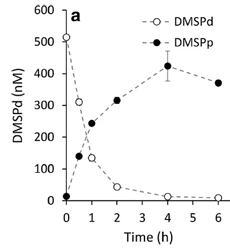D
MSP is the most abundant organic sulphur compound in our oceans and as such constitutes an important link in the biogeochemical cycling of sulphur. While DMSP is produced by many species of phytoplankton, the role of this ubiquitous molecule in the cellular physiology remains unknown.
I
n this research, we take a new approach to investigating the role of DMSP in phytoplankton cell physiology, where rather than focusing on a DMSP-producing organism, we exploit the propensity for the non-DMSP producing organisms to take up DMSP from their environment. This research uses the diatom Thalassiosira weissflogii as a model organism for luxury uptake and also investigates DMSP uptake by non-DMSP producing microalgae and prokaryotes in natural communities. Through this work, we aim to elucidate the physiological and ecological function(s) of DMSP in marine phytoplankton and bacteria.
Students: Eva Fernandez | Alyson Theseira
Collaborators: Daniel Aagren Nielsen | Justin Seymour
Funding: Australian Research Council | Linnean Society
Outputs: Petrou & Nielsen 2018 | Theseira et al. 2020 | Fernandez et al. 2021 | Fernandez et al. 2022
|

|
| Depletion of dissolved DMSP through uptake by Thalassiosira weissflogii over 6 hours. |
|
